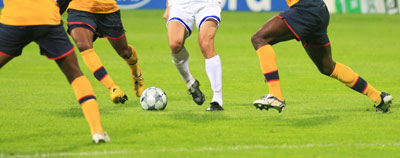Physical Preparation
Testing, intensity and scope of training
We introduce children-young soccer players to greater strain by increasing the intensity of their physical exercises.
In order to prevent damage to health during the course of training, it is desirable to have constant control (examination) by a specialist of sports medicine, testing of the level of physical capability, use of individual programs received after testing and control of program dosage.
All of these procedures require a serious approach to top soccer. In big and professional clubs today individual programs received after testing are largely in use with a personal trainer for each individual player.
With the advent of science (sports medicine) in sports we have the ability to follow development and obtain a clear picture of every successful future soccer player.
In addition to programming and individual dosage procedures such as EKG monitoring, physical composition analysis, aerobic capacity testing, energy balance evaluation and basic motor ability evaluation predominate.
EKG monitoring means monitoring the work of the heart with a under a load with classic tests – the Astrand test or PWC 130, 150, 170. A physical composition analysis enables a clear assessment of the quantity of fat tissue and muscle, an evaluation of the proportionality of physical composition and monitoring of changes in fat components as a result of exercise. T esting of the soccer players can be done under laboratory conditions or on the field. One of the most commonly used field tests is the 12-minute running test and the 2400 m test developed by Kenneth Cooper. This test enables us to test aerobic capacities in order to assess maximum use of oxygen (max VO2). esting of the soccer players can be done under laboratory conditions or on the field. One of the most commonly used field tests is the 12-minute running test and the 2400 m test developed by Kenneth Cooper. This test enables us to test aerobic capacities in order to assess maximum use of oxygen (max VO2).
The trainer is the person who defines and plans the phases of a single training. The intensity of work depends on the plan and program established earlier, as well as on the dosage of earlier trainings and the form of the players themselves and their results.
In order to prevent injury that can throw a soccer player out of the training and competitive process for several weeks or months, it is essential to constantly strengthen certain groups of muscles. For example, as a result of the neglect of the abdominal muscles, primarily the oblique, because of the difference in the strength of the muscles of the buttocks and the muscles of the abdominal wall over time what can happen is the opening of the upper part of the inguinal canal – the so-called abdominal hernia or as soccer players call it, groin pain (symphysis syndrome).
|

